From sky blue to lemon yellow, from jet black to snow white, birds come in every imaginable color. But nothing stands out among a lush green meadow or a snowy forest quite like a bird that’s brilliant red in color.
But if you’ve seen a red bird whistle past you while you were out in nature, you might not have had time to identify it correctly. We’re here to help!
North America is blessed with its fair share of red bird species, and here we’ll take you through some of the most radiant and striking examples on the continent. Are you red-dy?!
The Top Red Birds in North America
Northern Cardinal
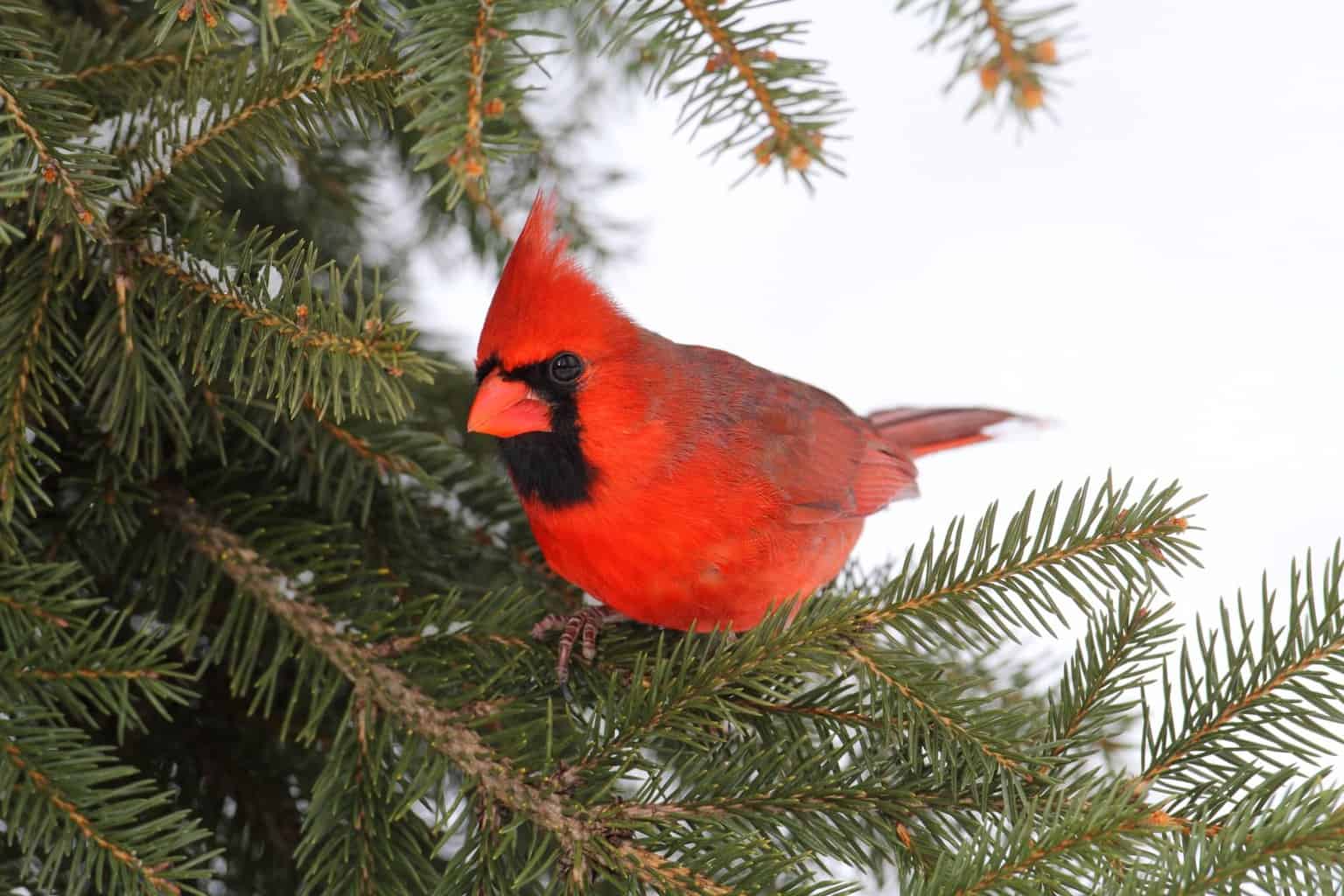
Also known as ‘red birds’ and ‘common cardinals’, Northern cardinals are probably the most famous of all the red birds in North America. Frequently turning up at several types of bird feeders, these vibrant visitors are wonderful for brightening up backyards on dull winter days.
To develop their incredible red plumage, northern cardinals need to eat seeds or fruit containing yellow pigment molecules. Their bodies then convert the yellow pigments into red.
Because males with the brightest feathers are more likely to win the fancy of the females, they’ll actively seek out foods that will help to brighten their colors. Bright red feathers also indicate better immunity, foraging ability, winter survival, and skill at avoiding predators.
Other than in backyards, northern cardinals can be found across southern and eastern parts of North America in parks, forest edges, and woodlots.
In the wild, they feed on invertebrates such as crickets, beetles, leafhoppers, flies, cicadas, centipedes, butterflies, and spiders, and fruits like wild grape, hackberry, mulberry, and blackberry.
Scarlet Tanager
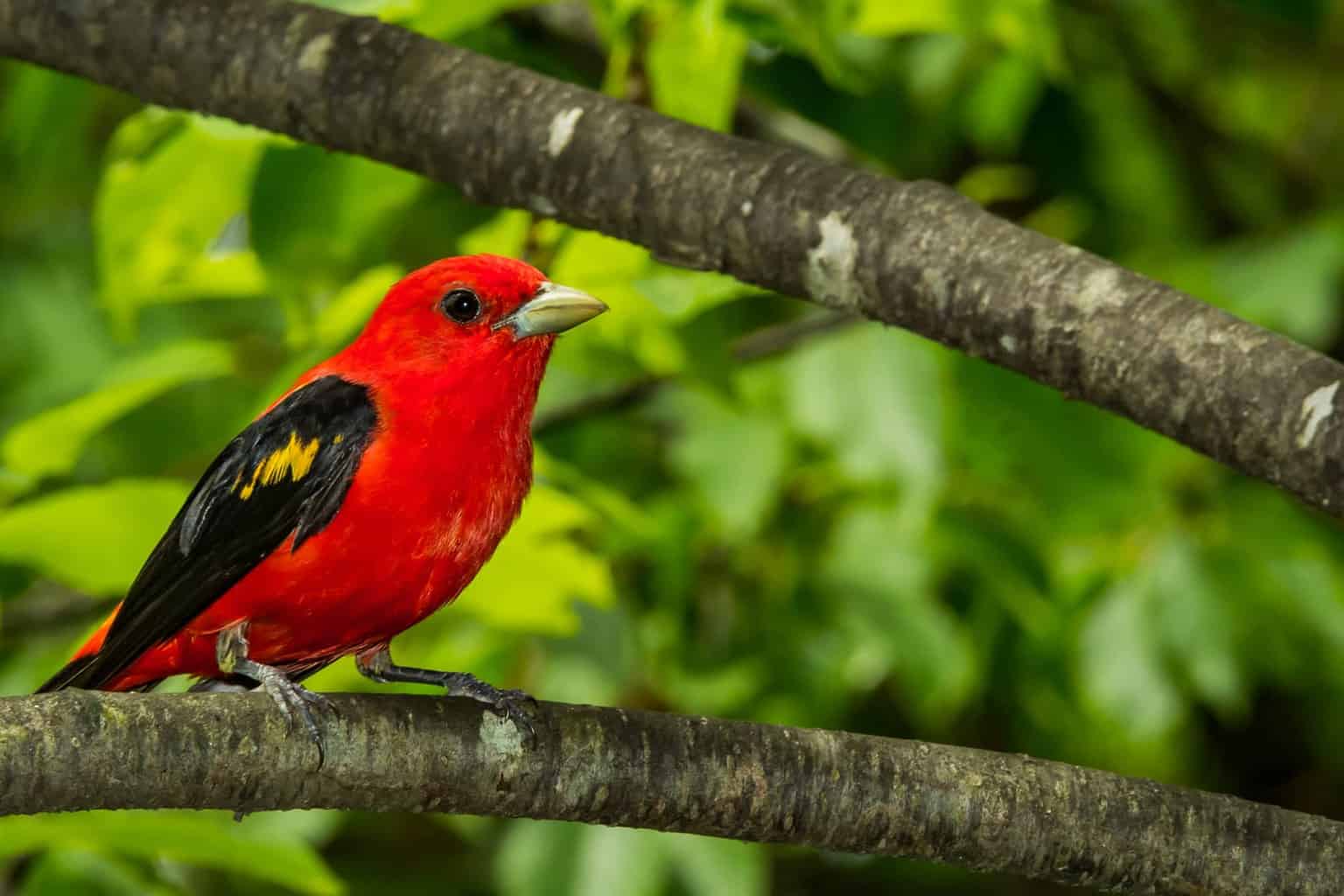
With their scarlet bodies and black wings and tail, male scarlet tanagers are a striking example of the red and black color combination that’s often seen in the bird world.
But unlike northern cardinals, scarlet tanagers only don their brightest colors during the warmer months. Once the breeding season has finished, males molt and take on a greenish-yellow color more like the females.
Scarlet tanagers are highly migratory birds with a vast nomadic range. In the summer, they nest in the Northeastern United States and Southeasterly parts of Canada, in winter they fly to Central and South America.
These woodland birds prefer mixed forests with large trees such as oak, hickory, hemlock, pine, and beech. During migration, however, they can be seen feeding in grassy fields and among scrubby vegetation.
Summer Tanager
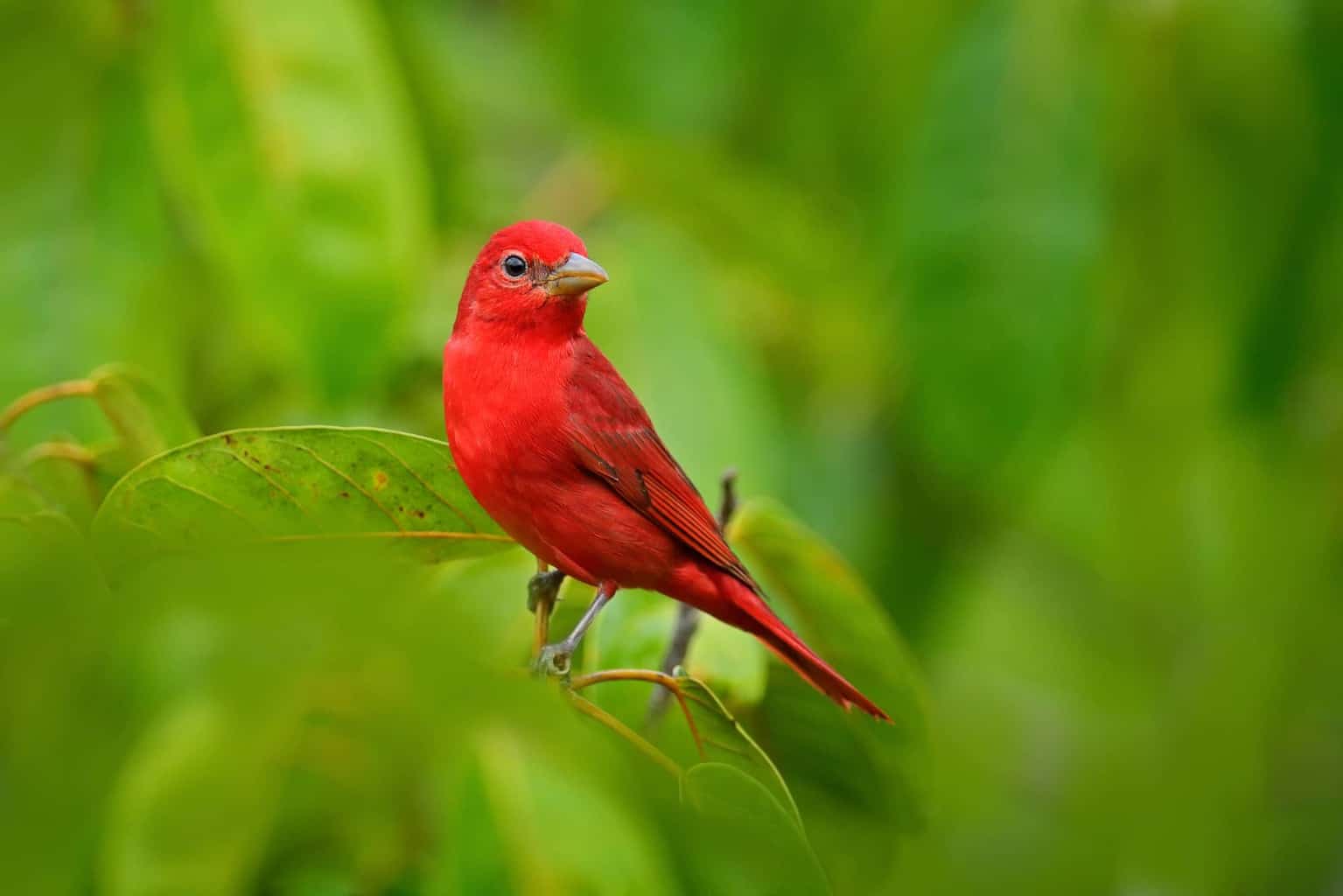
The summer tanager is so-called because it only appears in the United States during the breeding season. In the colder months, these warmth-loving birds return to the milder climates of Central America.
While the red color of the male summer tanager isn’t quite as brilliant as the scarlet tanager, they’re more uniform in color than their red and black cousins. Female summer tanagers are a highly attractive golden color.
In the United States, the summer tanager regularly appears from Arizona to Virginia, but can occasionally be seen as far west as California and as far north as New Jersey.
These stunning birds feed mostly on insects but occasionally on berries, too. Summer tanagers are famous for feeding on wasps and bees, but will also eat beetles, cicadas, caterpillars, grasshoppers, true bugs, flies, and spiders.
Hepatic Tanager
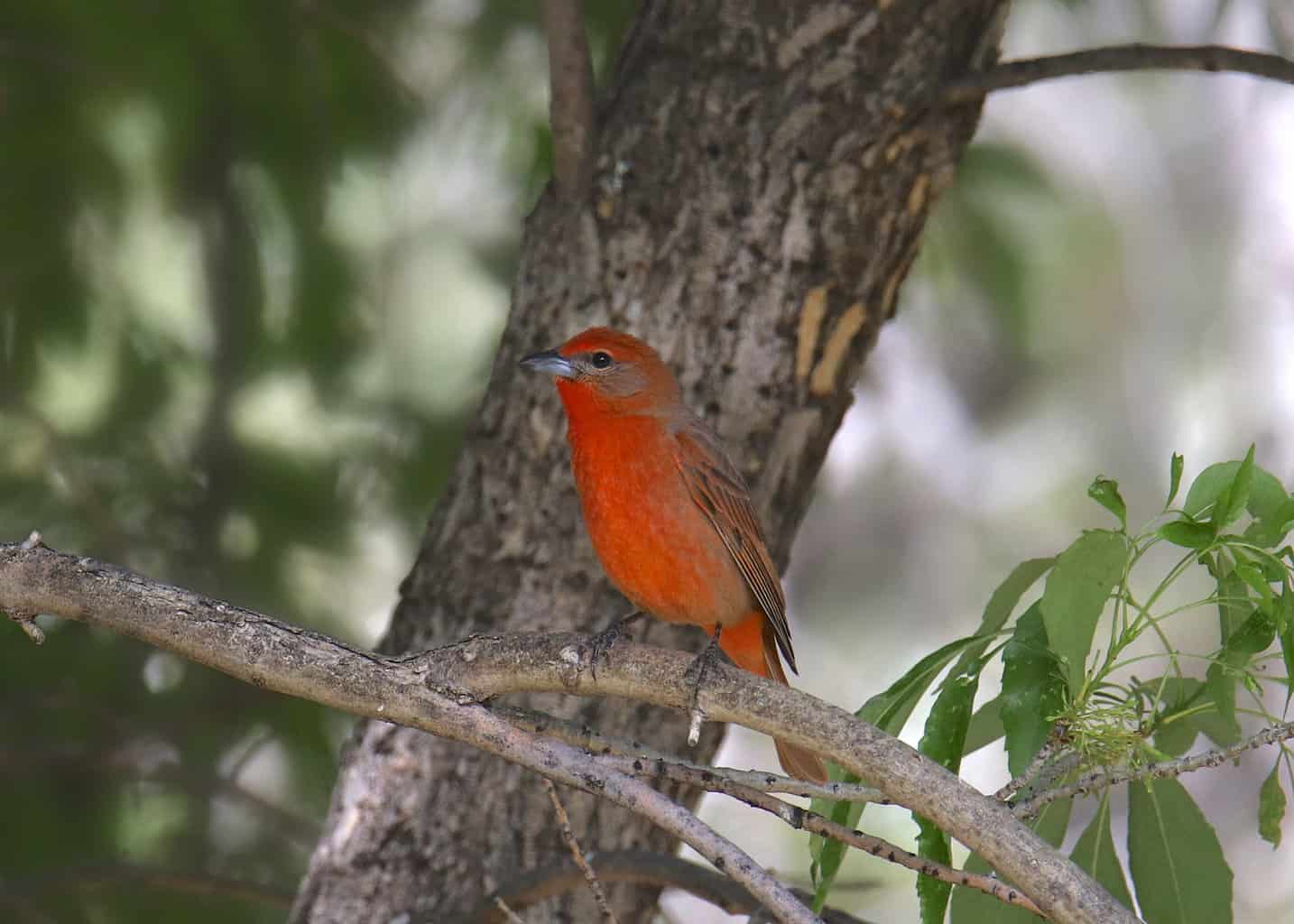
Compared with scarlet and summer tanagers, the male hepatic tanager sports a more mellow shade of red, mixed with dusty grayish plumage on its flanks, back, and face. Nonetheless, they’re still extremely striking birds, sure to stop you in your tracks when they fly by.
According to Sibley’s Guide to Birds, Hepatica tanagers are larger and stockier than the other tanagers, with relatively short tails and stout gray bills. In contrast to the red males, females are golden to light green and gray.
- Sibley Guide To Birds, 2nd Ed
- Sibley, David Allen (Author)
- English (Publication Language)
Last update on 2024-07-26 / Affiliate links / Images from Amazon Product Advertising API
Hepatic tanagers are only to be found during the breeding season in the southwesterly reaches of the United States, from Texas to California, but nowhere are they a common bird.
They’re mainly found in mountainous coniferous and oak forests and have very little overlap with the summer tanager, with whom they could be confused.
Vermillion Flycatcher
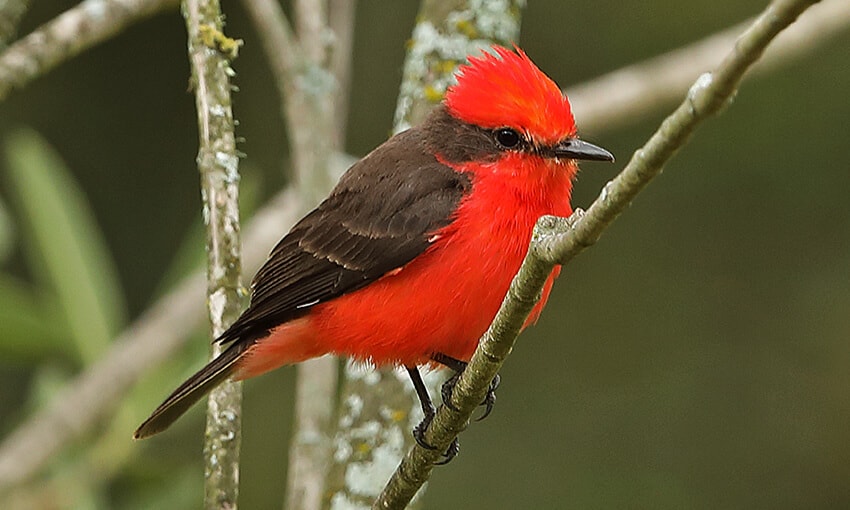
The bright red head and underside of the male vermillion flycatcher make it immediately stand out among the tyrant flycatchers – the largest family of birds in the world.
While most of its relatives are characterized by rather dull plumage, the male of this species is the only North American member of the family to boast bright red coloration. Females, conversely, are more drab, with a peach-colored belly with a dark gray upper side.
During the breeding season, the male performs an elaborate courtship flight-song display, puffing out his feathers and crest, flying high in the sky while singing rapidly, before returning to his perch.
If the female accepts his approach, she’ll build a nest in a horizontal tree fork from twigs, and weeds, decorated with lichens often held together with spider webs!
Typically for a flycatcher, Vermilion flycatchers feed almost exclusively on insects, including beetles, flies, grasshoppers, and wasps. These birds are more common in Central America, and only venture into the most southwesterly regions of the United States, from Texas to California.
Pine Grosbeak
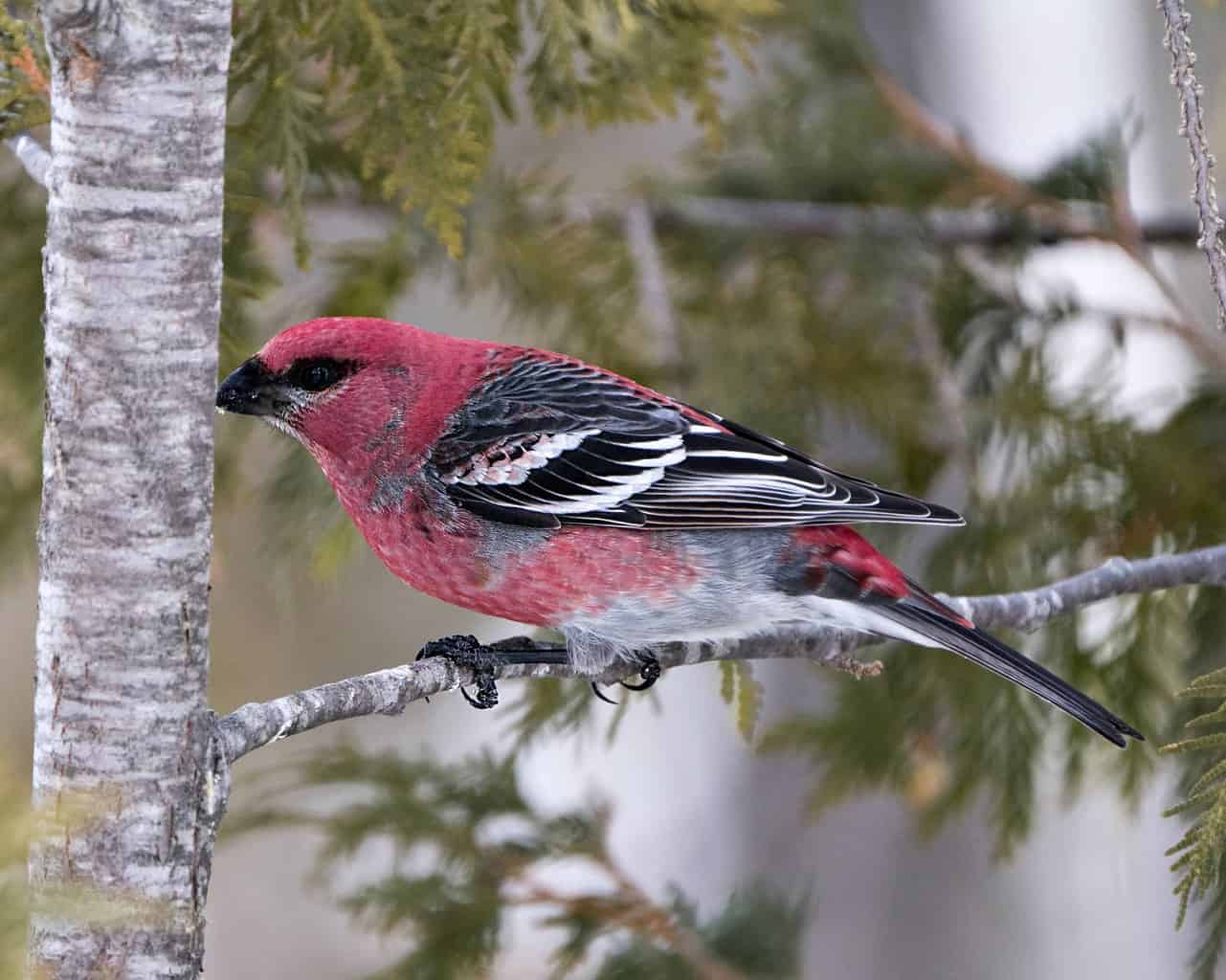
Male pine grosbeaks have a slightly more subtle coloration than cardinals and tanagers, but their striking pinkish-red and gray coloration earns them a place in our list of red birds nonetheless!
Pine grosbeaks (Pinicola enucleator) are large boreal finches that tend to dwell in the spruce and fir forests of Canada and Alaska, but they’re also found in coniferous forests in the rocky mountains and other high-altitude areas of the United States.
A curious attribute of the pine grosbeak is that they’re unbelievably tame, showing very little fear of humans. This makes observing them at close range fairly easy, although you could easily walk past one since they often remain motionless as you approach!
Except during the nesting season, pine grosbeaks tend to move around in small flocks. They feed methodically, slowly moving through trees, feeling on buds, conifer seeds, and fruit.
House Finch

One of the most widespread of all reddish birds in North America is the humble house finch. Although not quite as dazzling as some of the others on our list, male house finches do sport attractive red caps, chests, and rumps. As with many finches, females are a drab gray-brown color.
House finches are so-called because of their affinity to human habitation. These relatively tame birds are frequent visitors to backyard bird feeders, and will also regularly nest on or near buildings.
House finches could easily be confused with some of their close relatives, such as the purple finch and Cassin’s finch. They have longer tails than either of those species, though, as well as a shorter bill.
Unlike many of their relatives, the hardy house finch doesn’t migrate but stays within the same territories year-round. This means they sometimes have to withstand temperatures below -20°F in states like Minnesota and North Dakota. Brrrrr!
Painted Bunting
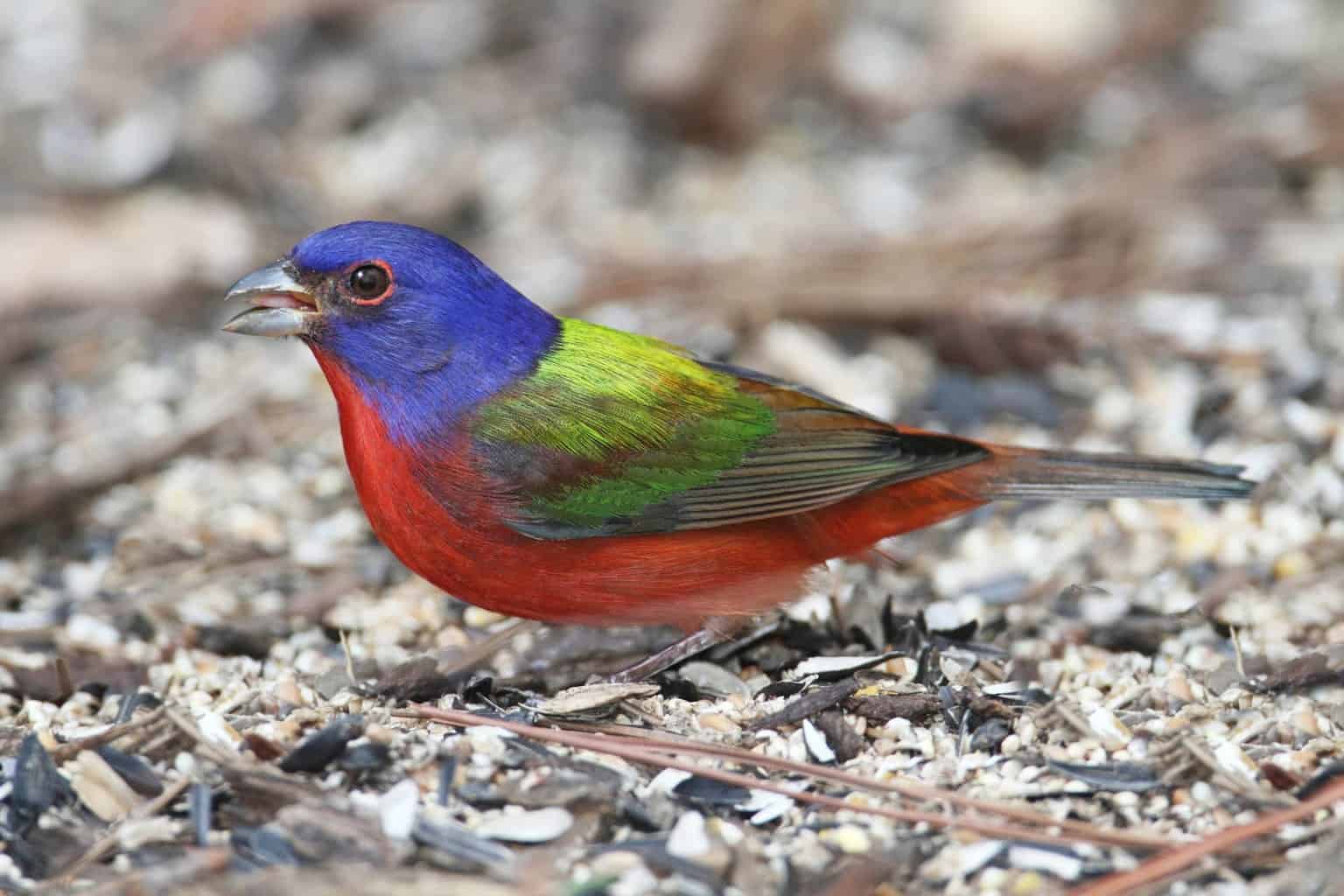
If there was ever a bird that deserved to be described as ‘painted’ it would surely be the painted bunting. With an indigo blue head, green back, and brilliant red underparts, the male-painted bunting is an absolute showstopper and a real treat for anyone lucky enough to spot one.
Although their bodies are composed of three main colors, the striking red underside of the male painted bunting is the most apparent pigment when they’re in flight. Females are a less exotic but still attractive green and golden color.
Except for an overwintering population in Southern Florida, painted buntings are purely summer birds in the United States. They are mostly found in brushy lowlands at forest edges in the southern half of the country.
Despite their incredible colors, painted buntings are uncommon, secretive birds, so are not the easiest birds to spot. Listen out for their sweet, high-pitched warble to help you locate them.
‘I’iwi (Scarlet Honeycreeper)

Now for a bird that’s not found in Mainland North America, but in Hawaii. The ‘I’iwi (pronounced “ee-EE-vee”) is an extraordinary-looking bright scarlet bird with a long hooked bill.
Once one of the most common forest birds of the Hawaiian Islands, the ‘I’iwi was an important sacred animal for the Early Hawaiians, who would use their colorful feathers to decorate ceremonial cloaks and helmets.
Sadly, the ‘I’iwi is now comparatively scarce in Hawaii and, like the Maui Parrotbill and the Palila, has disappeared from much of its former range. Habitat loss, predation from introduced mammals, as well as the onset of malaria on the islands have played a significant part in their downfall.
The ʻIʻiwi’s long, downward-curved bill is specially designed for reaching the nectar of tubular native lobelia and mint flowers. Now that these plants are less common, ‘I’iwis have had to feed on the ʻōhiʻa tree flowers, too. They also sometimes eat insects and spiders.
Northern Red Bishop

Now for the only bird on our list, that’s not native to the USA but still lives here. The northern red bishop (aka. orange bishop) is an exotic African bird that has naturalized in some warmer parts of the United States after being imported by pet bird enthusiasts.
The glorious deep red to orange and jet black colors of the male northern red bishop made it a popular caged bird. But, unhappy with being confined in captivity, several escaped and are now breeding in the Caribbean islands, California, Texas, and Florida.
Northern red bishops appear to be extremely adaptable to new environments and are usually found in weedy habitats, especially near the coast, in marshes, and on floor plains.
Attracting Red Birds to Your Garden
After learning about 10 of the most beautiful red birds that can be seen in North America, you might be wondering how you can see them more often.
A great way of attracting cardinals, house finches, and painted buntings to your backyard is by offering them food from a backyard feeder.
Platform feeders are a suitable choice for all of these species, and we’ve also created a dedicated guide to the very best bird food you can choose for red cardinals here.

